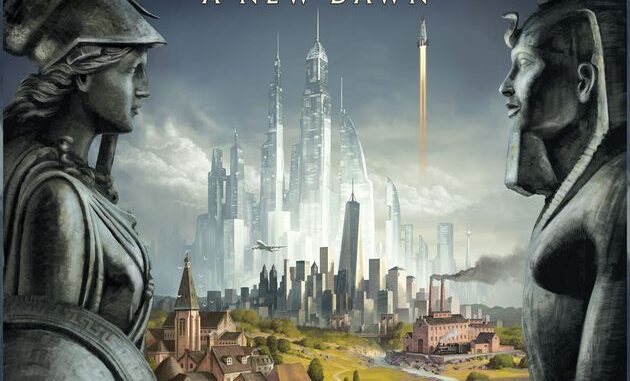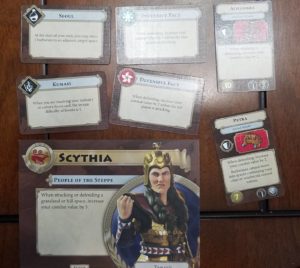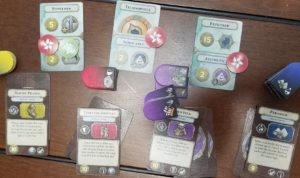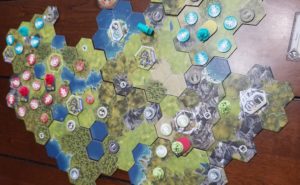
I have been a fan of the Civilization series of games since the beginning. Which, at this point, has been almost 30 years. So that’s fun to think about.
…
Anyways. Civilization is a great series of video game. It’s inspired my love of history. Even though it does kind of push a rather Western/Capitalist view of continuing exploitation and expansion that isn’t very nice if you think about it too much. It’s tried to make progress on that over the years. Plus, it’s a 4X game so that is unavoidable.
When the board game came out, I was interested. Then a new version came out that I heard didn’t take a thousand years to play. Civ is many things, but fast isn’t one of them. I picked up Civilization: A New Dawn and sat down to play with my son, who has also become a Civ junky.
Production- B+
The game’s map tiles don’t feel flimsy and are a nice thick cardboard. The tokens, likewise, are thick and feel sturdy despite being cardboard. The civilization cards, on the other hand, are quite flimsy but you don’t need to shuffle them or anything so it’s not a detriment. The rest of the cards are a bit sturdier.
The biggest drawbacks to the components are the city-state tokens and barbarian spawn points. It can be difficult to tell one city-state from another. They have a name on them but the text is quite small. Similarly, the barbarians have an icon with a letter embedded in the middle for the different barbarian tokens. It can be hard to read the letter based on how it fits into the icon. But this is a minor gripe.
Theme- B+

The game takes its style and art directly from Civilization VI, the current incarnation. This version has a bit more of a cartoony feel to it than previous versions. I’ve gotten used to it over the years. I wasn’t a big fan at the beginning though I never hated it like many. Either way, it works to connect the board game to the computer game.
Gameplay mechanics work to capture some of the epic feel. You do expand outward across the map. You do have barbarians to worry about. You are building wonders.
The biggest thing lacking is exploration. The whole map is laid out at the beginning of the game. I think this was my personal biggest disappointment. I love that part of Civ games. Seeing what the map has to offer.
Gameplay- B+
This one is hard to judge fairly. My first impression of the game was a disappointment. Despite buying this version, which was supposed to turn Civ into a board game that you could play in a reasonable amount of time, I was disappointed in how condensed and abstracted most of the concepts had become. No units, limited building, etc. Most everything was condensed and abstracted into player tokens which acted as territory, units, etc. This didn’t exactly provide the deep experience the computer game did.
So we played it twice and then put the box away for a year or so. Looking for new games to play during the lockdown, we took it out again and gave it another whirl. This time I knew what to expect and was able to look at it with a fresh perspective. The gameplay mechanics it does offer are decent on their own. They don’t quite capture the full Civ feel but then, that was never going to happen with a board game.

Players are able to perform one action on their turn from among five choices: Industry, Science, Military, Economics, Culture. All stables of Civ games. The cards are named after techs commonly found in Civ games. Each card has a different effect based on where it is on the action track; space 1-5 which correspond to a different type of terrain. The higher up the track, the more powerful the effect. Once an action has been used, it is moved into the 1 slot and everything else slides up a space.

Your action cards can be upgraded to move advanced versions using the Science action. Each player has a dial that tracks their science progress. As they earn more science points, they cross thresholds on the dial that give them new cards at different tiers or eras. You can only upgrade two cards to tier 2, two to tier 3 and two to tier 4 before you reach the end of the dial. That means you’ll never get all of your cards fully upgraded and will need to choose. Interestingly, the higher tier techs aren’t always better. Often the tier 3 and 4 cards offer different strategies to their use. For example, the tier 3 Industry tech makes building Wonders easier but you lose that ability with the tier 4 tech in exchange for easier city placement.

Industry techs allow you to build Wonders or cities. This is how you lay claim to the map and gain resources. Resources are used to help reduce the cost of Wonders. Depending on which Wonder you build, it can drastically alter your strategy. The Terracotta Army wonder, for example, makes it so Barbarians can’t attack your cities. If you happened to build near a spawn camp, this can be great early game. You can spend your Military actions reinforcing or attacking other players instead of defending yourself from barbarians.
Culture techs allow you to claim territory on your map around your cities. Several victory conditions require you to claim a certain number or type of tiles. You also get bonus resources every few rounds for every ‘mature’ city, i.e., cities with all the tiles around them claimed. Claimed tiles helps defend your territory from other players and barbarians. It is also how you claim the resources on the board.
Military techs are how you defend yourself. You typically have the choice between reinforcing your tiles or attacking something; either another player or barbarians. Reinforced tiles are harder to take and keep barbarians out. Attacking has limited ranged and effect based on how advanced the tech is.
Economy techs allow you to send trade caravans across the map to other players cities or to city-states. When you first trade with someone, you get to take a diplomacy card from that that gives you a benefit. The city-states each have two cards with the same effect, so if you’re not one of the first two Civs to trade with them you miss out. Each player has the same set of cards but one of each. You could claim the Defensive Pact from other Civs to protect yourself from a more aggressive player.
In addition to claiming a Diplomacy card, trading also earns you trade goods. These tokens are added to techs to enhance the tech’s effect when used. For instance, when you use Culture to claim tiles, you can spend your trade goods to claim more tiles with that action. Trade goods are very handy in maximizing the effect of each tech.

Each slot on the action board corresponds to a different type of terrain on the map; plains, hills, forests, desert and mountains. Depending on the tech action you’re doing, its slot will limit what you can do it. For example, tiles claimed with Culture can be of types equal to or lower than the terrain of the slot Culture is in. If Culture was in slot 3, you can’t claim any desert or mountain tiles. For military, the slot number is a bonus on your attack. It is also a bonus for the defender based on whatever tile you’re attacking.
Winning the game requires you to complete three objectives which are different every game, though there are only a small number of objective cards so you will see them frequently. Each card has two options on it, giving you some choices on how to approach the game. The two options usually involve one of two types of approaches; building something or claiming something. For example, you could build two purple Wonders or claim fifteen tiles bordering water or the board edge.
Expansions- None
There are not currently any expansions for this game, nor am I aware of any planned.
Conclusion- B+
Despite my initial disappointment, the game can be fun. It’s not the full Civ experience but you have the computer game for that. Once you get the basic understanding of how turns work, it flows quickly. Each turn you only really have one choice to make and can be planning your next move while others do theirs. The game can be competitive or low impact depending on your player group. Its possible to win without ever attacking or threatening other players. But that is also a potential strategy.
If you’re looking for a relatively simple 4X style game that can be played during a normal game session you could do worse then A New Dawn.
